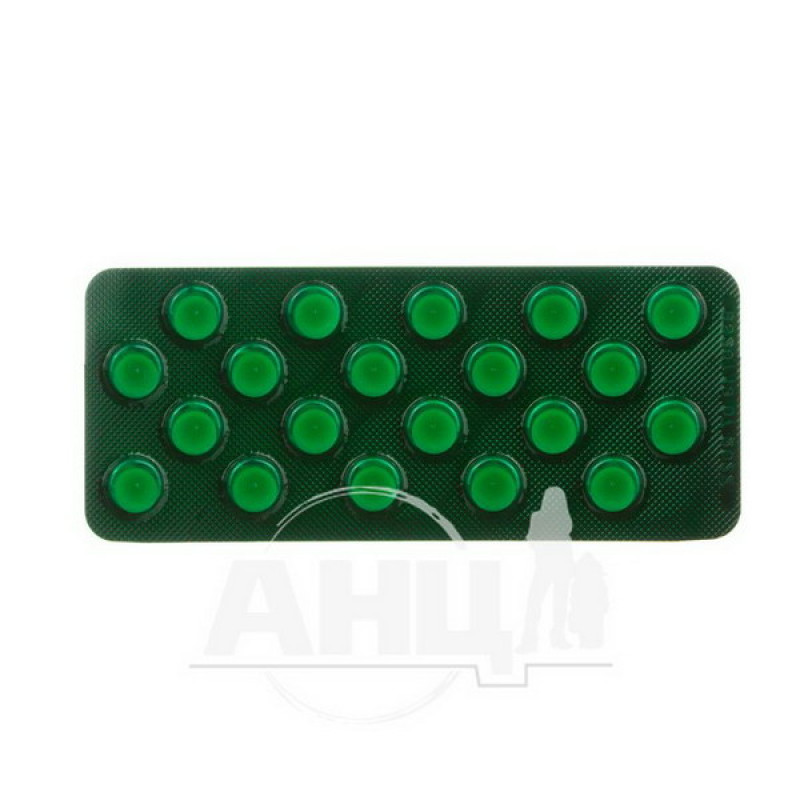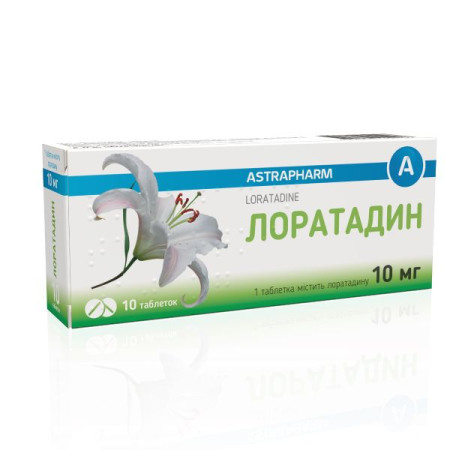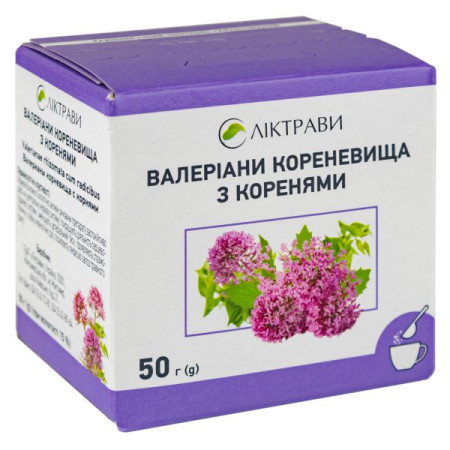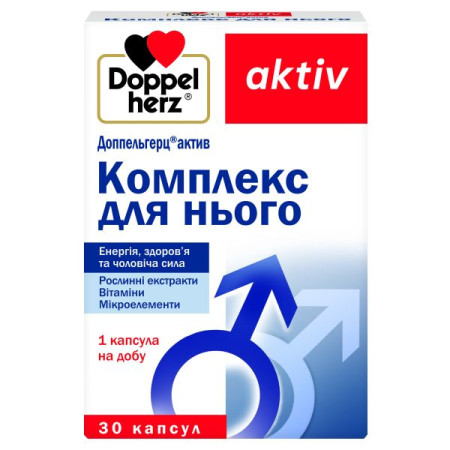Bromhexine-Darnitsa tablets 8 mg No. 20
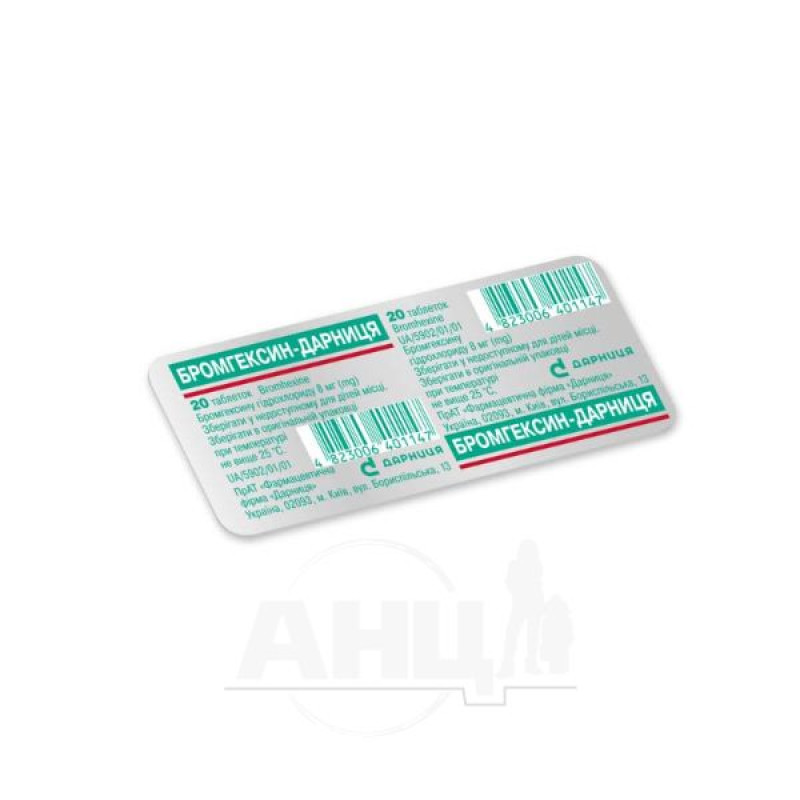
Translation of the instructions can be
BROMHEXINE-DARNYTSYA tablets 8 mgInstruction
For medical use of the medicinal product
Composition:
Active ingredient: bromhexine;
1 tablet contains bromhexine hydrochloride 8 mg;
Excipients: lactose monohydrate, potato starch, calcium stearate.
Dosage form.
Pills.
Main physicochemical properties: white tablets of flat-cylindrical shape with a bevel.
Pharmacotherapeutic group.
Medicines used for coughs and colds. Mucolytics. ATC code r05c b02.
Pharmacological properties.
Pharmacodynamics.
The drug exhibits mucolytic (secretolytic) and expectorant effects. The mucolytic effect is associated with depolymerization and liquefaction of mucoprotein and mucopolysaccharide fibers. One of the important features of the action of bromhexine is its ability to stimulate the formation of surfactant - a surface-active substance of lipid-protein-mucopolysaccharide nature, which is synthesized in the cells of the alveoli; surfactant biosynthesis is disrupted in various bronchopulmonary diseases, which leads to a violation of the stability of alveolar cells, weakening their response to adverse effects.
Pharmacokinetics.
Bromhexine is rapidly absorbed from the gastrointestinal tract. Bioavailability is about 20%. In healthy volunteers, the maximum concentration (C max) in plasma is determined after 1 hour. The binding of bromhexine to plasma proteins is high. It is widely distributed in the tissues of the body. Bromhexine penetrates the blood-brain barrier. In small quantities, it penetrates the placenta. With prolonged repeated use, it can accumulate. It undergoes intensive metabolism during the first passage through the liver. In the liver, it undergoes demethylation and oxidation. The main metabolite of bromhexine is ambroxol. About 85-90% is excreted from the body with urine, mainly in the form of metabolites. The half-life (T 1/2) is 12-15 hours due to slow reverse diffusion from the tissues.
Clinical characteristics.
Indication.
Secretolytic therapy for acute and chronic bronchopulmonary diseases accompanied by complications of sputum discharge.
Contraindication.
Hypersensitivity to the components of the drug; gastric and duodenal ulcers; diseases of the respiratory system, accompanied by the formation of abundant liquid sputum.
Interaction with other drugs and other types of interactions.
Antibiotics (amoxicillin, cefuroxime, erythromycin, doxycycline), sulfonamide drugs - when used in combination with bromhexine, the concentrations of antibiotics and sulfonamides in bronchopulmonary secretions and sputum increase.
Antitussives - combined use with bromhexine leads to the accumulation of mucus in the respiratory tract and difficulty in removing sputum from the bronchi against the background of a decrease in cough. Such a combination is not recommended.
Drugs that irritate the digestive tract (for example, nonsteroidal anti-inflammatory drugs) - when used in combination with bromhexine, mutual enhancement of the effects of mucosal irritation is possible.
Bromhexine-Darnitsa can be prescribed in combination with bronchodilators, antibacterials, and drugs used in cardiology.
Application features.
During treatment, it is necessary to take a sufficient amount of fluid, which enhances the expectorant effect of bromhexine. If there is a history of gastric bleeding, bromhexine should be used under the supervision of a doctor.
Use the drug with caution in patients suffering from bronchial asthma and in patients with renal or severe hepatic insufficiency (i.e. increase the intervals between doses or reduce the dose).
In acute renal failure, the possibility of accumulation of bromhexine metabolites in the liver must be taken into account.
With prolonged use of the drug, it is recommended to monitor liver function from time to time.
The medicine contains lactose, therefore patients with rare hereditary forms of galactose intolerance, lactase deficiency or glucose-galactose malabsorption syndrome should not take the medicine.
At the first signs of any skin or mucous membrane disorders while using bromhexine hydrochloride, the drug should be discontinued immediately (this may be the beginning of the development of such severe complications as Stevens-Johnson syndrome or Lyell's syndrome).
Use during pregnancy or breastfeeding.
During pregnancy, the drug should be prescribed taking into account the benefit to the mother/risk to the fetus ratio.
During breastfeeding, the use of bromhexine is contraindicated due to its penetration into breast milk.
The ability to influence the speed of reactions when driving vehicles or other mechanisms.
There are no reports that the drug may affect the ability to drive or operate other mechanisms.
Method of administration and doses.
The drug should be taken orally, regardless of meals. The duration of administration depends on the indications and course of the disease and is determined individually.
Children from 6 to 14 years old, as well as patients with a body weight of less than 50 kg: 1 tablet (4-8 mg) 3 times a day. The course of treatment is 4-5 days.
In case of impaired kidney function or severe liver disease, the dose of the drug must be reduced.
Children.
The medicine should be used in children from 6 years of age. Children under 6 years of age should be used in other dosage forms.
Overdose.
Symptoms: dyspeptic disorders, nausea, vomiting, diarrhea, dizziness, headache, diplopia, ataxia, mild metabolic acidosis, tachypnea. When using up to 40 mg of bromhexine in young children, no symptoms were observed even without decontamination. No chronic toxic effects on humans were detected.
Treatment: induce vomiting, gastric lavage (in the first 1-2 hours after ingestion), symptomatic therapy. In case of significant overdose, cardiovascular system monitoring should be carried out. Due to the high degree of binding to plasma proteins, large volume of distribution and slow reverse distribution of bromhexine from tissues to the blood, no acceleration of drug excretion should be expected during hemodialysis or forced diuresis.
Adverse reactions.
From the nervous system: headache (migraine type), dizziness.
From the respiratory system, chest organs and mediastinum: increased cough, bronchospasm, respiratory disorders, respiratory distress.
On the part of the gastrointestinal tract: dyspeptic phenomena, nausea, vomiting, diarrhea, abdominal pain, exacerbation of gastric and duodenal ulcers, transient increase in the activity of aminotransferases in the blood serum.
On the part of the immune system: hypersensitivity reactions, including skin rashes, erythematous and urticaria, skin itching, urticaria; very rarely - Quincke's edema, anaphylactic reactions, including anaphylactic shock; extremely rarely, severe skin lesions have been reported: Stevens-Johnson syndrome and Lyell's syndrome, associated with the use of mucolytic agents such as bromhexine. For the most part, they could be explained by the severity of the underlying disease or the simultaneous administration of other drugs. If skin reactions or reactions on the mucous membranes occur, the patient should stop taking the drug and consult a doctor.
General disorders and administration site conditions: increased sweating, fever.
Expiration date.
3 years.
Storage conditions.
Store in the original packaging at a temperature not exceeding 25 ° C. Keep out of the reach of children.
Packaging.
10 tablets in a blister; 5 blisters in a pack; 10 or 20 tablets in contour cell packs.
Vacation category.
Without a prescription.
Producer.
Chao "Darnitsa Pharmaceutical Company".
Location of the manufacturer and address of its place of business.
Ukraine, 02093, Kyiv, Boryspilska St., 13.
There are no reviews for this product.
There are no reviews for this product, be the first to leave your review.
No questions about this product, be the first and ask your question.






